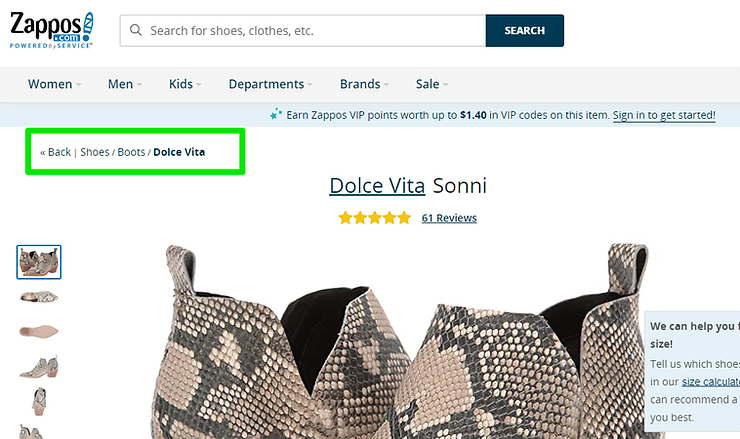What is a Breadcrumb?
In the context of web development and user interface design, a breadcrumb refers to a navigational element that helps users track and understand their current location within a website or application. It typically appears as a horizontal trail of links, usually located near the top of a webpage, just below the primary navigation menu.
The term “breadcrumb” is derived from the fairytale Hansel and Gretel, in which the characters drop breadcrumbs to create a trail and find their way back home. Similarly, digital breadcrumbs serve as a visual path for users to retrace their steps within a website.
Each element of the breadcrumb trail represents a specific level in the website’s hierarchy, starting from the homepage and leading to the current page. For example, a breadcrumb trail for a hypothetical e-commerce website might look like this:
Home > Category > Subcategory > Product
Clicking on any of the links in the breadcrumb trail allows users to quickly navigate to a higher-level page. This feature is particularly useful on large websites or platforms with complex navigation structures, as it provides users with contextual information and allows them to understand their location within the site.

One discussion we’ve been having recently, with the sudden rise in popularity of ChatGPT and other AI chatbots, is whether marketeers have decided to embrace AI with their workload (particularly with content creation) or whether they’re standing tall in their defiance against the machines.
How Does Breadcrumb Effect SEO and User Experience?
Breadcrumbs can have a positive impact on both SEO (Search Engine Optimisation) and user experience. Here’s how they affect each aspect:
SEO Benefits:
- Improved site structure: Breadcrumbs provide search engines with a clearer understanding of your website’s structure and hierarchy. They help search engines comprehend the relationship between different pages and how they relate to the overall website structure.
- Keyword relevance: Breadcrumb links often contain keywords that are relevant to the page’s content. These keywords can contribute to better SEO by reinforcing the topical relevance of the page and potentially improving its rankings for those keywords.
- Rich snippets: In search engine results, breadcrumbs can appear as rich snippets, displaying the navigational path to a specific page. This enhanced display can increase visibility, click-through rates, and overall SEO performance.
- Improved navigation: Breadcrumbs provide users with a clear and visual representation of their location within a website. They help users understand how different pages are related and allow them to navigate back to higher-level pages easily. This enhances overall user navigation and reduces the chances of users feeling disoriented or lost.
- Time-saving: Breadcrumbs offer users a quick way to jump to higher-level pages without relying on the browser’s back button repeatedly. Users can directly click on the relevant breadcrumb link to navigate to the desired section, saving time and effort.
- Contextual understanding: Breadcrumbs provide contextual information by displaying the page’s position within the site’s hierarchy. This helps users understand the relationship between different sections, categories, or subcategories and reinforces the overall site structure in their minds.
- Increased engagement: By making navigation more intuitive and efficient, breadcrumbs contribute to a positive user experience. Users are more likely to stay engaged and explore more areas of a website if they can easily understand where they are and how to navigate to other relevant sections.
Overall, breadcrumbs can improve both SEO and user experience by enhancing site structure, providing keyword relevance, aiding navigation, and offering contextual understanding to users. Implementing breadcrumbs correctly can be a valuable addition to a website’s design and optimisation efforts.

Should I Add Breadcrumbs Into My Website?
Adding breadcrumbs to your website can be beneficial in most cases. However, the decision ultimately depends on the specific characteristics of your website and the needs of your users. Here are some factors to consider when deciding whether to implement breadcrumbs:
Website structure: If your website has a hierarchical structure with multiple levels or sections, breadcrumbs can provide a clear visual representation of that structure. Breadcrumbs are especially useful for websites with complex navigation, e-commerce platforms with numerous categories and subcategories, or content-heavy sites with multiple sections.
User navigation: Assess how users interact with your website and whether breadcrumbs would enhance their navigation experience. If your website has a deep hierarchy or users frequently need to backtrack to higher-level pages, breadcrumbs can simplify this process and improve user engagement.
Mobile responsiveness: Breadcrumbs can be particularly valuable for mobile users who may have limited screen space and need an alternative to traditional navigation menus. Breadcrumbs offer a compact and user-friendly way to navigate through a website on smaller screens.
Content freshness: Consider the frequency of content updates on your website. If you frequently add or remove pages, or if the structure changes dynamically, ensure that your breadcrumbs dynamically reflect these changes to avoid confusing users.
Design considerations: Evaluate how breadcrumbs fit into your website’s overall design and aesthetic. Breadcrumbs should be implemented in a visually appealing and unobtrusive manner, complementing your website’s style without distracting or cluttering the interface.
Technical implementation: Implementing breadcrumbs should be feasible within your website’s technical framework. Depending on your website platform or content management system, there may be existing plugins, modules, or templates available for easy implementation. Alternatively, you may need to customise the implementation to fit your specific needs.
In summary, assess the structure of your website, consider the benefits for user navigation, evaluate mobile responsiveness, and weigh the design and technical aspects. If the implementation aligns with these considerations, adding breadcrumbs to your website can generally be a positive enhancement for both SEO and user experience.











We have been working with Amax Marketing for the last few weeks and have already been impressed with the results we've seen.
As experts in outreach and digital PR, we knew we'd be in safe hands. We are looking forward to the coming months, and getting some fantastic results!